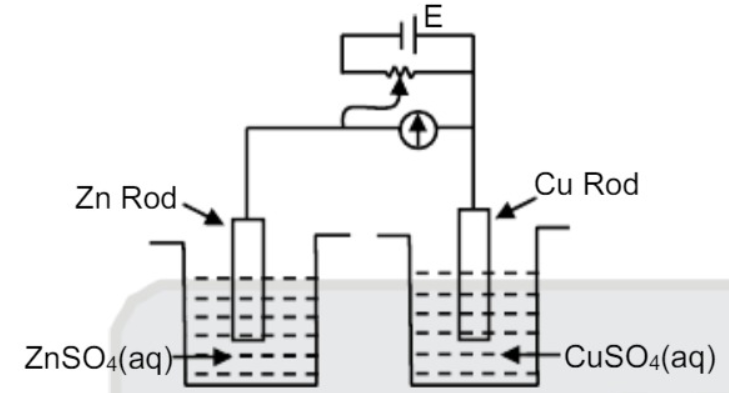Copper from copper sulphate solution can be displacesd by. (The standard reduction potentials of some electrodes are given below):
Eo(Fe2+/Fe)=−0.44V,Eo(Zn2+/Zn)=−0.76V
Eo(Cu2+/Cu)=+0.34V:Eo(Cr3+/Cr)=−0.74V
Eo(H+/12H2)=0.00V
H2
Zn
Cr
All of these
The correct Answer is:D
To determine which species can displace copper from a copper sulfate solution, we need to analyze the standard reduction potentials provided for various electrodes. The relevant standard reduction potentials are:
- E∘(Cu2+/Cu)=+0.34V
- E∘(Fe2+/Fe)=−0.44V
- E∘(Zn2+/Zn)=−0.76V
- E∘(Cr3+/Cr)=−0.74V
- E∘(H+/H2)=0.00V
1. Understanding Displacement Reaction:
A metal can displace another metal from its salt solution if it has a higher oxidation potential (or lower reduction potential). In this case, we want to see if any of the given metals can displace copper from copper sulfate.
2. Identify the Reduction Potential of Copper:
The standard reduction potential for copper is +0.34V. This means that copper ions (Cu2+) can easily be reduced to copper metal.
3. Compare Other Metals' Reduction Potentials:
We will compare the reduction potentials of the other metals with that of copper:
- Iron: E∘(Fe2+/Fe)=−0.44V (lower than copper)
- Zinc: E∘(Zn2+/Zn)=−0.76V (lower than copper)
- Chromium: E∘(Cr3+/Cr)=−0.74V (lower than copper)
- Hydrogen: E∘(H+/H2)=0.00V (lower than copper)
4. Conclusion:
All the given metals (Fe, Zn, Cr, and H) have lower reduction potentials than copper. Therefore, they can all displace copper from copper sulfate solution.
5. Final Answer:
The correct answer is that copper can be displaced by all of these species. Thus, the answer is option 4: "All of these".
- E∘(Fe2+/Fe)=−0.44V
- E∘(Zn2+/Zn)=−0.76V
- E∘(Cr3+/Cr)=−0.74V
- E∘(H+/H2)=0.00V
A metal can displace another metal from its salt solution if it has a higher oxidation potential (or lower reduction potential). In this case, we want to see if any of the given metals can displace copper from copper sulfate.
The standard reduction potential for copper is +0.34V. This means that copper ions (Cu2+) can easily be reduced to copper metal.
We will compare the reduction potentials of the other metals with that of copper:
- Iron: E∘(Fe2+/Fe)=−0.44V (lower than copper)
- Zinc: E∘(Zn2+/Zn)=−0.76V (lower than copper)
- Chromium: E∘(Cr3+/Cr)=−0.74V (lower than copper)
- Hydrogen: E∘(H+/H2)=0.00V (lower than copper)
All the given metals (Fe, Zn, Cr, and H) have lower reduction potentials than copper. Therefore, they can all displace copper from copper sulfate solution.
The correct answer is that copper can be displaced by all of these species. Thus, the answer is option 4: "All of these".
Topper's Solved these Questions
- ELECTROCHEMISTRYBOOK - VMC MODULES ENGLISHCHAPTER - ELECTROCHEMISTRYEXERCISE - EFFICIENT
46 Videos
- ELECTROCHEMISTRYBOOK - VMC MODULES ENGLISHCHAPTER - ELECTROCHEMISTRYEXERCISE - IMPECCABLE
50 Videos
- ELECTROCHEMISTRYBOOK - VMC MODULES ENGLISHCHAPTER - ELECTROCHEMISTRYEXERCISE - FUNDAMENTAL
50 Videos
- CLASSIFICATION OF ELEMENTS AND PERIODICITY IN PROPERTIES BOOK - VMC MODULES ENGLISHCHAPTER - CLASSIFICATION OF ELEMENTS AND PERIODICITY IN PROPERTIES EXERCISE - JEE ADVANCE (ARCHIVE)
30 Videos
- ENVIRONMENTAL CHEMISTRYBOOK - VMC MODULES ENGLISHCHAPTER - ENVIRONMENTAL CHEMISTRYEXERCISE - JEE Main (Archive)
39 Videos
Similar Questions
Knowledge Check
Using the standard electrode potential, find out the pair between which redox reaction is not feasible. E∘ values : Fe3+/Fe2+=+0.77,I2/I−=+0.54V
Cu2+/Cu=+0.34V,Ag+/Ag=+0.80VAFe3+ and I−BAg+ and CuCFe3+ and CuDAg and Fe3+
For the given cell arrangement identify incorrect statement
given E∘_(Cu2+/Cu) = 0.34V &E∘_(Zn2+/Zn)=−0.76V
View SolutionE∘Cu2+/Cu=0.34V
E∘Cu+/Cu=0.522V
E∘Cu2+/Cu+=
View SolutionE∘Cu2+/Cu=0.34V
E∘Cu+/Cu=0.522V
E∘Cu2+/Cu+=
View SolutionWhat is the standard reduction potential (E∘) for Fe3+→Fe?
Given that :
Fe2++2e−→Fe,E∘Fe2+/Fe=-0.47V
Fe3++e−→Fe2+,E∘Fe3+/Fe2+=+0.77V
View SolutionThe standard reduction potential data at 25∘C is given below
E∘(Fe3+,Fe2+)=+0.77V,
E∘(Fe2+,Fe)=−0.44V,
E∘(Cu2+,Cu)=+0.34V,
E∘(Cu+,Cu)=+0.52V,
E∘(O2(g)+4H++4e−→2H2O]=+1.23V
E∘[(O2(g)+2H2O+4e−→4OH−)]=+0.40V,
E∘(Cr3+,Cr)=−0.74V,
E∘(Cr2+,Cr)=−0.91V,
Match E∘ of the redox pair in List-I with the values given in List-II and select the correct answer using the code given below teh lists:
List−IList−II(P)E∘(Fe3+,Fe)(1)−0.18V(Q)E∘(4H2O⇔4H++4OH+)(2)−0.4V(R)E∘(Cu2++Cu→2Cu+)(3)−0.04V(S)E∘(Cr3+,Cr2+)(4)−0.83V
Codes:
View SolutionThe standard reduction potential data at 25∘C is given below
E∘(Fe3+,Fe2+)=+0.77V,
E∘(Fe2+,Fe)=−0.44V,
E∘(Cu2+,Cu)=+0.34V,
E∘(Cu+,Cu)=+0.52V,
E∘(O2(g)+4H++4e−→2H2O]=+1.23V
E∘[(O2(g)+2H2O+4e−→4OH−)]=+0.40V,
E∘(Cr3+,Cr)=−0.74V,
E∘(Cr2+,Cr)=−0.91V,
Match E∘ of the redox pair in List-I with the values given in List-II and select the correct answer using the code given below the lists:
List−IList−II(P)E∘(Fe3+,Fe)(1)−0.18V(Q)E∘(4H2O⇔4H++4OH−)(2)−0.4V(R)E∘(Cu2++Cu→2Cu+)(3)−0.04V(S)E∘(Cr3+,Cr2+)(4)−0.83V
Codes:
View SolutionThe standard electrode potential of the half cells are given below :
Zn2++2e−→Zn(s),Eo=−7.62V
Fe2++2e−→Fe(s),Eo=−7.81V
The emf of the cell Fe2++Zn→Zn2++Fe will be :
View Solution